Analysis and Report of a Third Grade Student's DIBELS Assessment
VerifiedAdded on 2022/09/06
|7
|1761
|16
Report
AI Summary
This report presents a DIBELS assessment conducted on a third-grade student struggling with letter recognition, particularly 'g' and 'q', while demonstrating strong reading comprehension. The assessment, including LNF, WWR, and ORF tests, revealed the need for intensive support in several areas. The report details the assessment process, including the student's performance on various DIBELS measures, data analysis, and instructional decisions. The assessment involved a 30-minute lesson plan focused on letter recognition. The report also suggests activities like tactile cards and dough stamping to improve letter understanding. The author reflects on the assessment experience, highlighting the student's challenges and strengths. The author emphasizes the importance of the DIBELS benchmark test in identifying skills for predicting reading performance and overall reading outcomes. The report concludes with references to relevant literature and assessment tools.
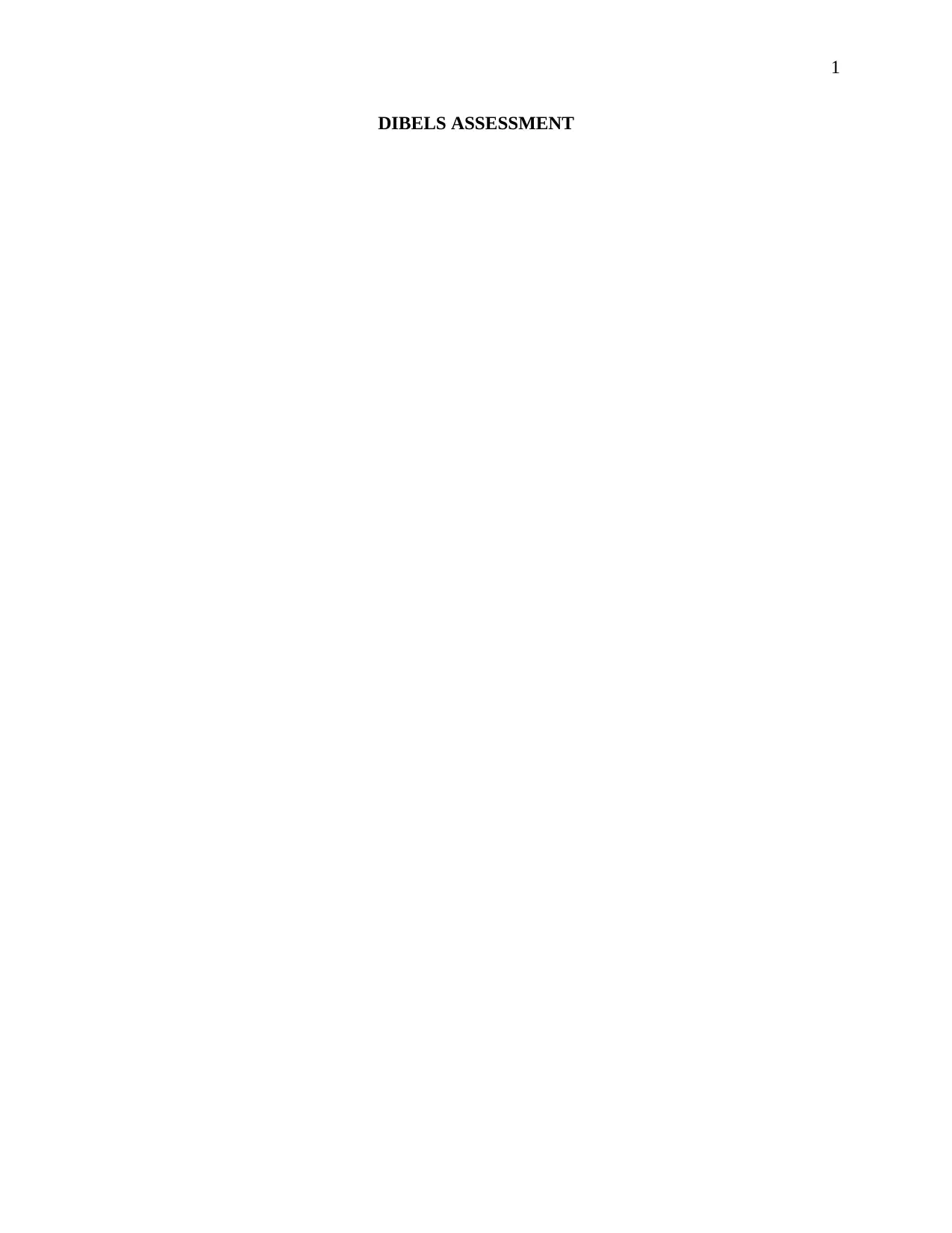
1
DIBELS ASSESSMENT
DIBELS ASSESSMENT
Paraphrase This Document
Need a fresh take? Get an instant paraphrase of this document with our AI Paraphraser
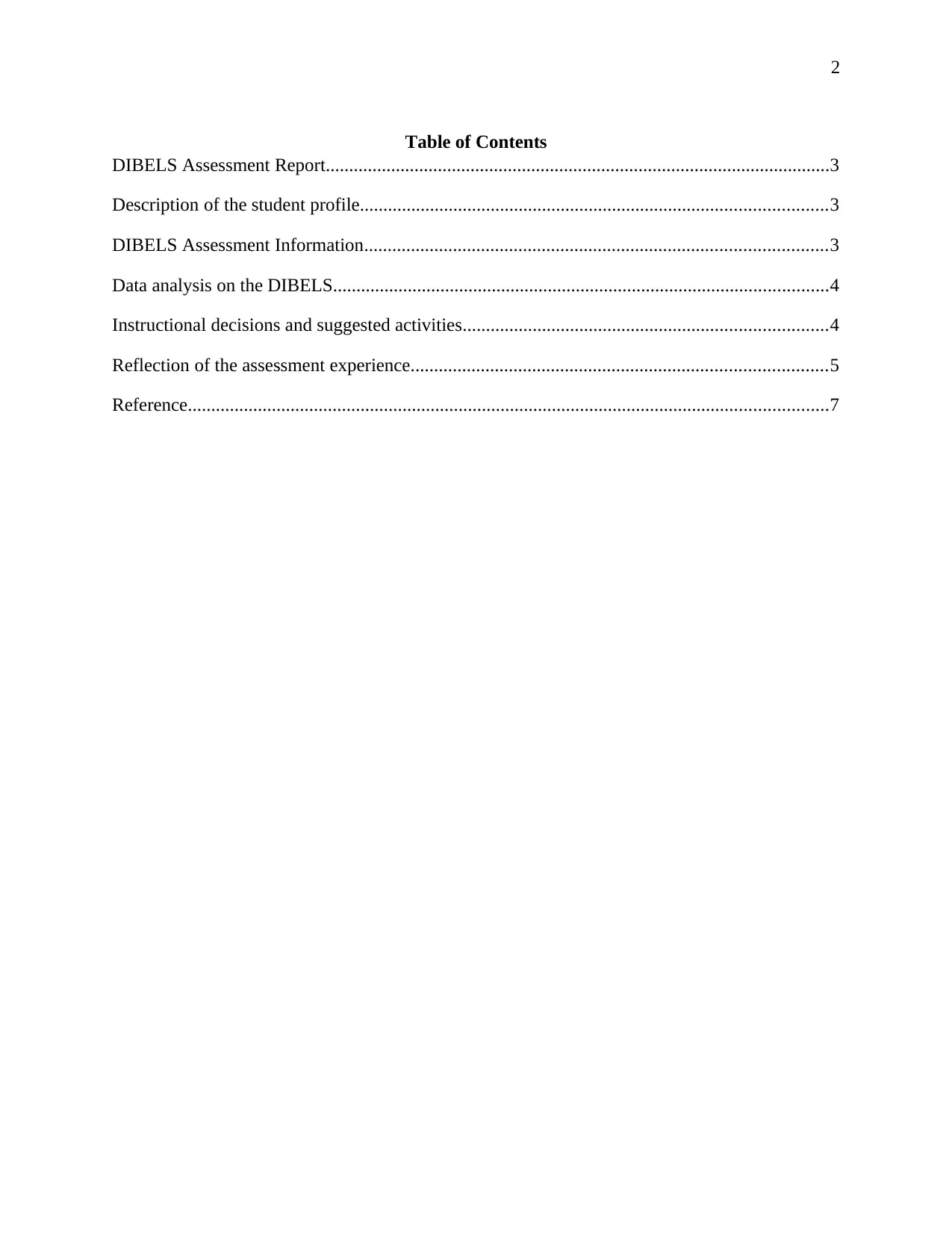
2
Table of Contents
DIBELS Assessment Report............................................................................................................3
Description of the student profile....................................................................................................3
DIBELS Assessment Information...................................................................................................3
Data analysis on the DIBELS..........................................................................................................4
Instructional decisions and suggested activities..............................................................................4
Reflection of the assessment experience.........................................................................................5
Reference.........................................................................................................................................7
Table of Contents
DIBELS Assessment Report............................................................................................................3
Description of the student profile....................................................................................................3
DIBELS Assessment Information...................................................................................................3
Data analysis on the DIBELS..........................................................................................................4
Instructional decisions and suggested activities..............................................................................4
Reflection of the assessment experience.........................................................................................5
Reference.........................................................................................................................................7
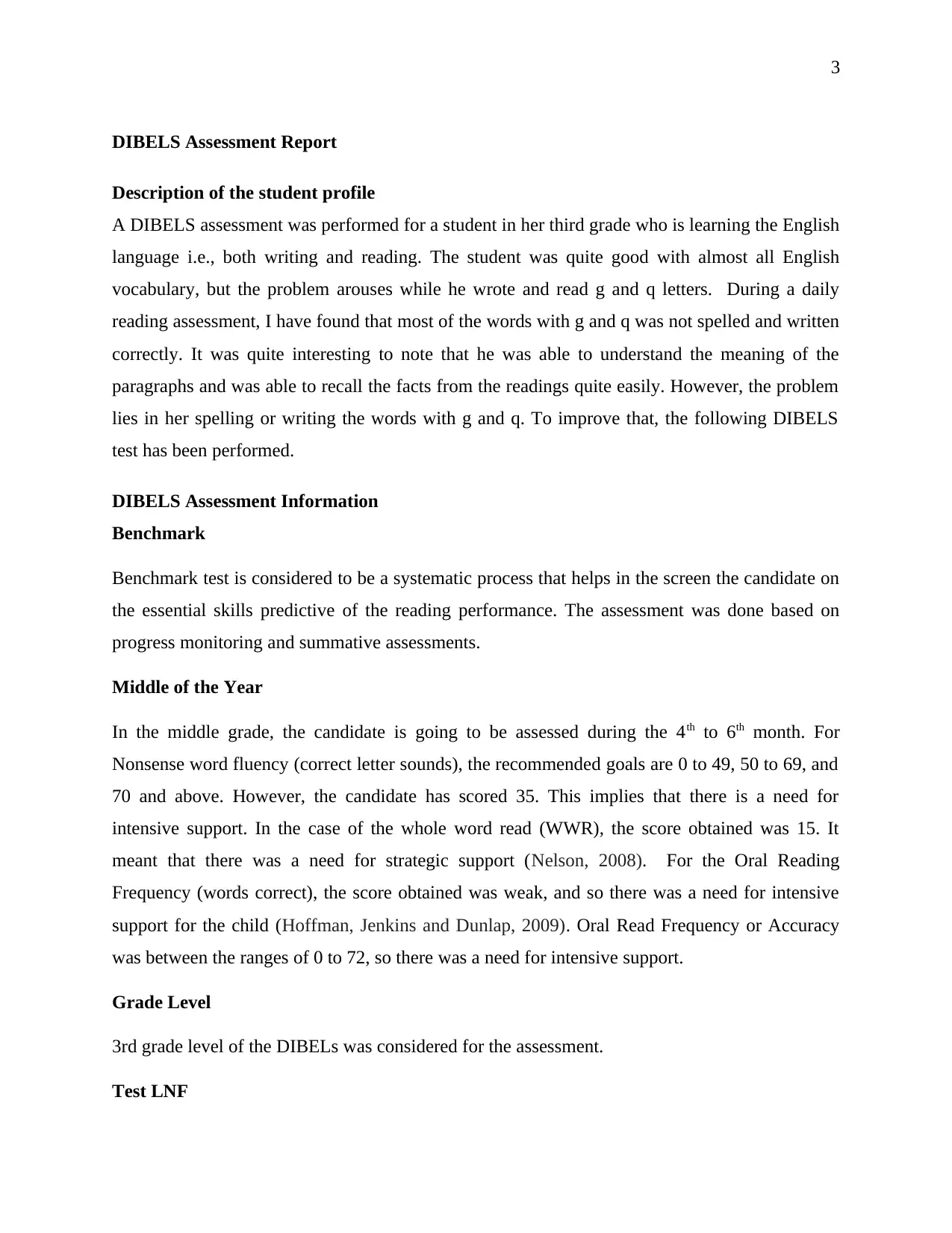
3
DIBELS Assessment Report
Description of the student profile
A DIBELS assessment was performed for a student in her third grade who is learning the English
language i.e., both writing and reading. The student was quite good with almost all English
vocabulary, but the problem arouses while he wrote and read g and q letters. During a daily
reading assessment, I have found that most of the words with g and q was not spelled and written
correctly. It was quite interesting to note that he was able to understand the meaning of the
paragraphs and was able to recall the facts from the readings quite easily. However, the problem
lies in her spelling or writing the words with g and q. To improve that, the following DIBELS
test has been performed.
DIBELS Assessment Information
Benchmark
Benchmark test is considered to be a systematic process that helps in the screen the candidate on
the essential skills predictive of the reading performance. The assessment was done based on
progress monitoring and summative assessments.
Middle of the Year
In the middle grade, the candidate is going to be assessed during the 4th to 6th month. For
Nonsense word fluency (correct letter sounds), the recommended goals are 0 to 49, 50 to 69, and
70 and above. However, the candidate has scored 35. This implies that there is a need for
intensive support. In the case of the whole word read (WWR), the score obtained was 15. It
meant that there was a need for strategic support (Nelson, 2008). For the Oral Reading
Frequency (words correct), the score obtained was weak, and so there was a need for intensive
support for the child (Hoffman, Jenkins and Dunlap, 2009). Oral Read Frequency or Accuracy
was between the ranges of 0 to 72, so there was a need for intensive support.
Grade Level
3rd grade level of the DIBELs was considered for the assessment.
Test LNF
DIBELS Assessment Report
Description of the student profile
A DIBELS assessment was performed for a student in her third grade who is learning the English
language i.e., both writing and reading. The student was quite good with almost all English
vocabulary, but the problem arouses while he wrote and read g and q letters. During a daily
reading assessment, I have found that most of the words with g and q was not spelled and written
correctly. It was quite interesting to note that he was able to understand the meaning of the
paragraphs and was able to recall the facts from the readings quite easily. However, the problem
lies in her spelling or writing the words with g and q. To improve that, the following DIBELS
test has been performed.
DIBELS Assessment Information
Benchmark
Benchmark test is considered to be a systematic process that helps in the screen the candidate on
the essential skills predictive of the reading performance. The assessment was done based on
progress monitoring and summative assessments.
Middle of the Year
In the middle grade, the candidate is going to be assessed during the 4th to 6th month. For
Nonsense word fluency (correct letter sounds), the recommended goals are 0 to 49, 50 to 69, and
70 and above. However, the candidate has scored 35. This implies that there is a need for
intensive support. In the case of the whole word read (WWR), the score obtained was 15. It
meant that there was a need for strategic support (Nelson, 2008). For the Oral Reading
Frequency (words correct), the score obtained was weak, and so there was a need for intensive
support for the child (Hoffman, Jenkins and Dunlap, 2009). Oral Read Frequency or Accuracy
was between the ranges of 0 to 72, so there was a need for intensive support.
Grade Level
3rd grade level of the DIBELs was considered for the assessment.
Test LNF
⊘ This is a preview!⊘
Do you want full access?
Subscribe today to unlock all pages.

Trusted by 1+ million students worldwide
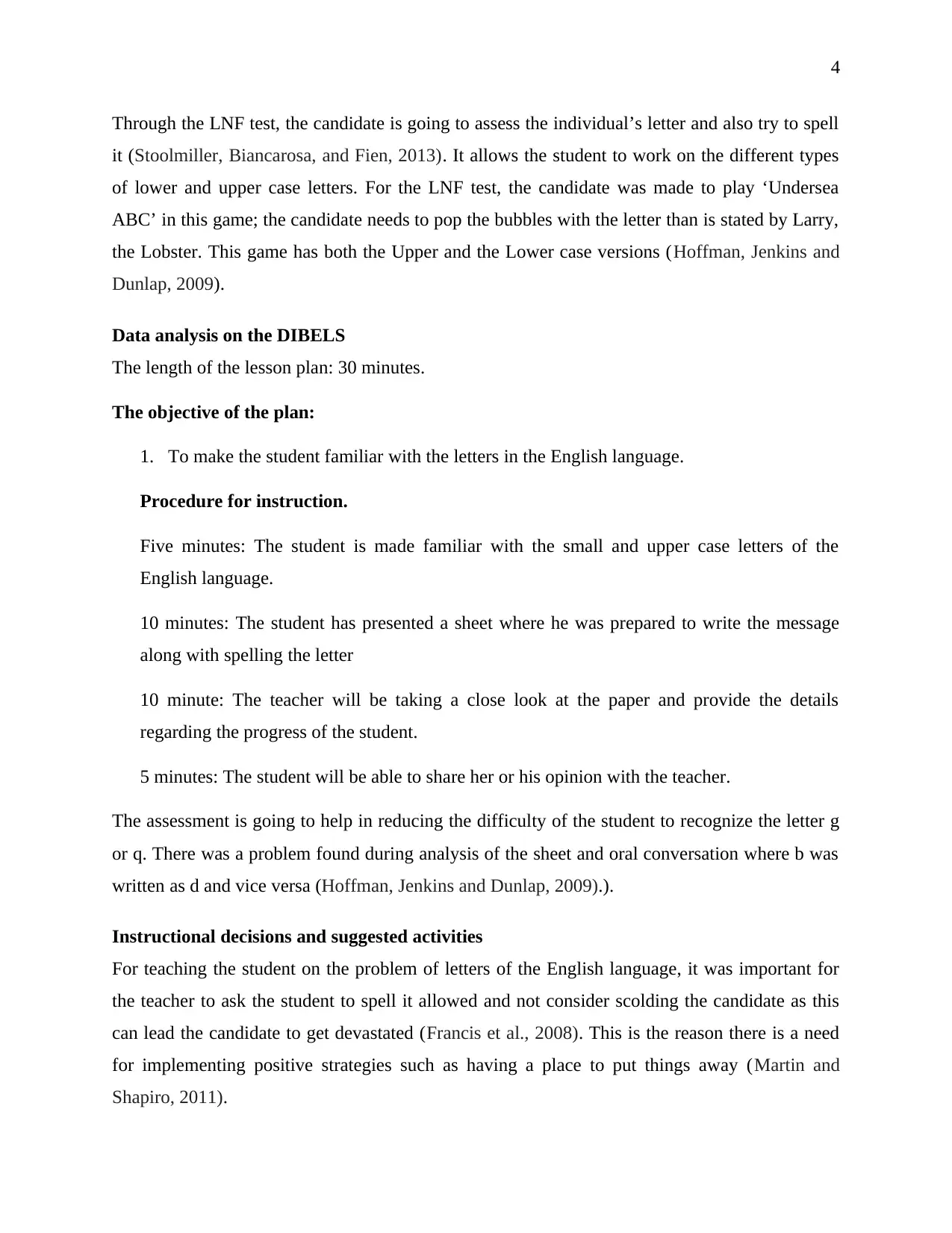
4
Through the LNF test, the candidate is going to assess the individual’s letter and also try to spell
it (Stoolmiller, Biancarosa, and Fien, 2013). It allows the student to work on the different types
of lower and upper case letters. For the LNF test, the candidate was made to play ‘Undersea
ABC’ in this game; the candidate needs to pop the bubbles with the letter than is stated by Larry,
the Lobster. This game has both the Upper and the Lower case versions (Hoffman, Jenkins and
Dunlap, 2009).
Data analysis on the DIBELS
The length of the lesson plan: 30 minutes.
The objective of the plan:
1. To make the student familiar with the letters in the English language.
Procedure for instruction.
Five minutes: The student is made familiar with the small and upper case letters of the
English language.
10 minutes: The student has presented a sheet where he was prepared to write the message
along with spelling the letter
10 minute: The teacher will be taking a close look at the paper and provide the details
regarding the progress of the student.
5 minutes: The student will be able to share her or his opinion with the teacher.
The assessment is going to help in reducing the difficulty of the student to recognize the letter g
or q. There was a problem found during analysis of the sheet and oral conversation where b was
written as d and vice versa (Hoffman, Jenkins and Dunlap, 2009).).
Instructional decisions and suggested activities
For teaching the student on the problem of letters of the English language, it was important for
the teacher to ask the student to spell it allowed and not consider scolding the candidate as this
can lead the candidate to get devastated (Francis et al., 2008). This is the reason there is a need
for implementing positive strategies such as having a place to put things away (Martin and
Shapiro, 2011).
Through the LNF test, the candidate is going to assess the individual’s letter and also try to spell
it (Stoolmiller, Biancarosa, and Fien, 2013). It allows the student to work on the different types
of lower and upper case letters. For the LNF test, the candidate was made to play ‘Undersea
ABC’ in this game; the candidate needs to pop the bubbles with the letter than is stated by Larry,
the Lobster. This game has both the Upper and the Lower case versions (Hoffman, Jenkins and
Dunlap, 2009).
Data analysis on the DIBELS
The length of the lesson plan: 30 minutes.
The objective of the plan:
1. To make the student familiar with the letters in the English language.
Procedure for instruction.
Five minutes: The student is made familiar with the small and upper case letters of the
English language.
10 minutes: The student has presented a sheet where he was prepared to write the message
along with spelling the letter
10 minute: The teacher will be taking a close look at the paper and provide the details
regarding the progress of the student.
5 minutes: The student will be able to share her or his opinion with the teacher.
The assessment is going to help in reducing the difficulty of the student to recognize the letter g
or q. There was a problem found during analysis of the sheet and oral conversation where b was
written as d and vice versa (Hoffman, Jenkins and Dunlap, 2009).).
Instructional decisions and suggested activities
For teaching the student on the problem of letters of the English language, it was important for
the teacher to ask the student to spell it allowed and not consider scolding the candidate as this
can lead the candidate to get devastated (Francis et al., 2008). This is the reason there is a need
for implementing positive strategies such as having a place to put things away (Martin and
Shapiro, 2011).
Paraphrase This Document
Need a fresh take? Get an instant paraphrase of this document with our AI Paraphraser
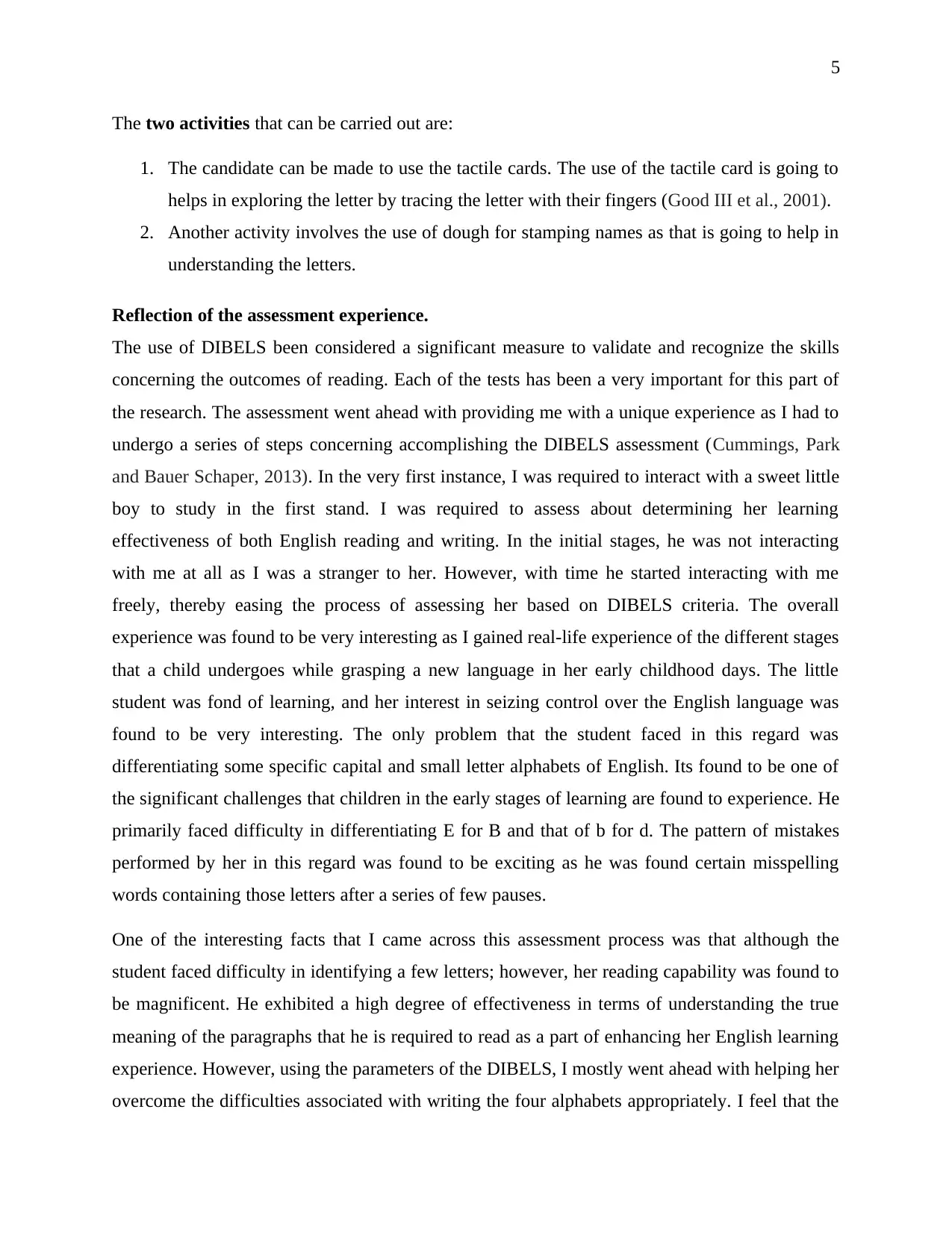
5
The two activities that can be carried out are:
1. The candidate can be made to use the tactile cards. The use of the tactile card is going to
helps in exploring the letter by tracing the letter with their fingers (Good III et al., 2001).
2. Another activity involves the use of dough for stamping names as that is going to help in
understanding the letters.
Reflection of the assessment experience.
The use of DIBELS been considered a significant measure to validate and recognize the skills
concerning the outcomes of reading. Each of the tests has been a very important for this part of
the research. The assessment went ahead with providing me with a unique experience as I had to
undergo a series of steps concerning accomplishing the DIBELS assessment (Cummings, Park
and Bauer Schaper, 2013). In the very first instance, I was required to interact with a sweet little
boy to study in the first stand. I was required to assess about determining her learning
effectiveness of both English reading and writing. In the initial stages, he was not interacting
with me at all as I was a stranger to her. However, with time he started interacting with me
freely, thereby easing the process of assessing her based on DIBELS criteria. The overall
experience was found to be very interesting as I gained real-life experience of the different stages
that a child undergoes while grasping a new language in her early childhood days. The little
student was fond of learning, and her interest in seizing control over the English language was
found to be very interesting. The only problem that the student faced in this regard was
differentiating some specific capital and small letter alphabets of English. Its found to be one of
the significant challenges that children in the early stages of learning are found to experience. He
primarily faced difficulty in differentiating E for B and that of b for d. The pattern of mistakes
performed by her in this regard was found to be exciting as he was found certain misspelling
words containing those letters after a series of few pauses.
One of the interesting facts that I came across this assessment process was that although the
student faced difficulty in identifying a few letters; however, her reading capability was found to
be magnificent. He exhibited a high degree of effectiveness in terms of understanding the true
meaning of the paragraphs that he is required to read as a part of enhancing her English learning
experience. However, using the parameters of the DIBELS, I mostly went ahead with helping her
overcome the difficulties associated with writing the four alphabets appropriately. I feel that the
The two activities that can be carried out are:
1. The candidate can be made to use the tactile cards. The use of the tactile card is going to
helps in exploring the letter by tracing the letter with their fingers (Good III et al., 2001).
2. Another activity involves the use of dough for stamping names as that is going to help in
understanding the letters.
Reflection of the assessment experience.
The use of DIBELS been considered a significant measure to validate and recognize the skills
concerning the outcomes of reading. Each of the tests has been a very important for this part of
the research. The assessment went ahead with providing me with a unique experience as I had to
undergo a series of steps concerning accomplishing the DIBELS assessment (Cummings, Park
and Bauer Schaper, 2013). In the very first instance, I was required to interact with a sweet little
boy to study in the first stand. I was required to assess about determining her learning
effectiveness of both English reading and writing. In the initial stages, he was not interacting
with me at all as I was a stranger to her. However, with time he started interacting with me
freely, thereby easing the process of assessing her based on DIBELS criteria. The overall
experience was found to be very interesting as I gained real-life experience of the different stages
that a child undergoes while grasping a new language in her early childhood days. The little
student was fond of learning, and her interest in seizing control over the English language was
found to be very interesting. The only problem that the student faced in this regard was
differentiating some specific capital and small letter alphabets of English. Its found to be one of
the significant challenges that children in the early stages of learning are found to experience. He
primarily faced difficulty in differentiating E for B and that of b for d. The pattern of mistakes
performed by her in this regard was found to be exciting as he was found certain misspelling
words containing those letters after a series of few pauses.
One of the interesting facts that I came across this assessment process was that although the
student faced difficulty in identifying a few letters; however, her reading capability was found to
be magnificent. He exhibited a high degree of effectiveness in terms of understanding the true
meaning of the paragraphs that he is required to read as a part of enhancing her English learning
experience. However, using the parameters of the DIBELS, I mostly went ahead with helping her
overcome the difficulties associated with writing the four alphabets appropriately. I feel that the
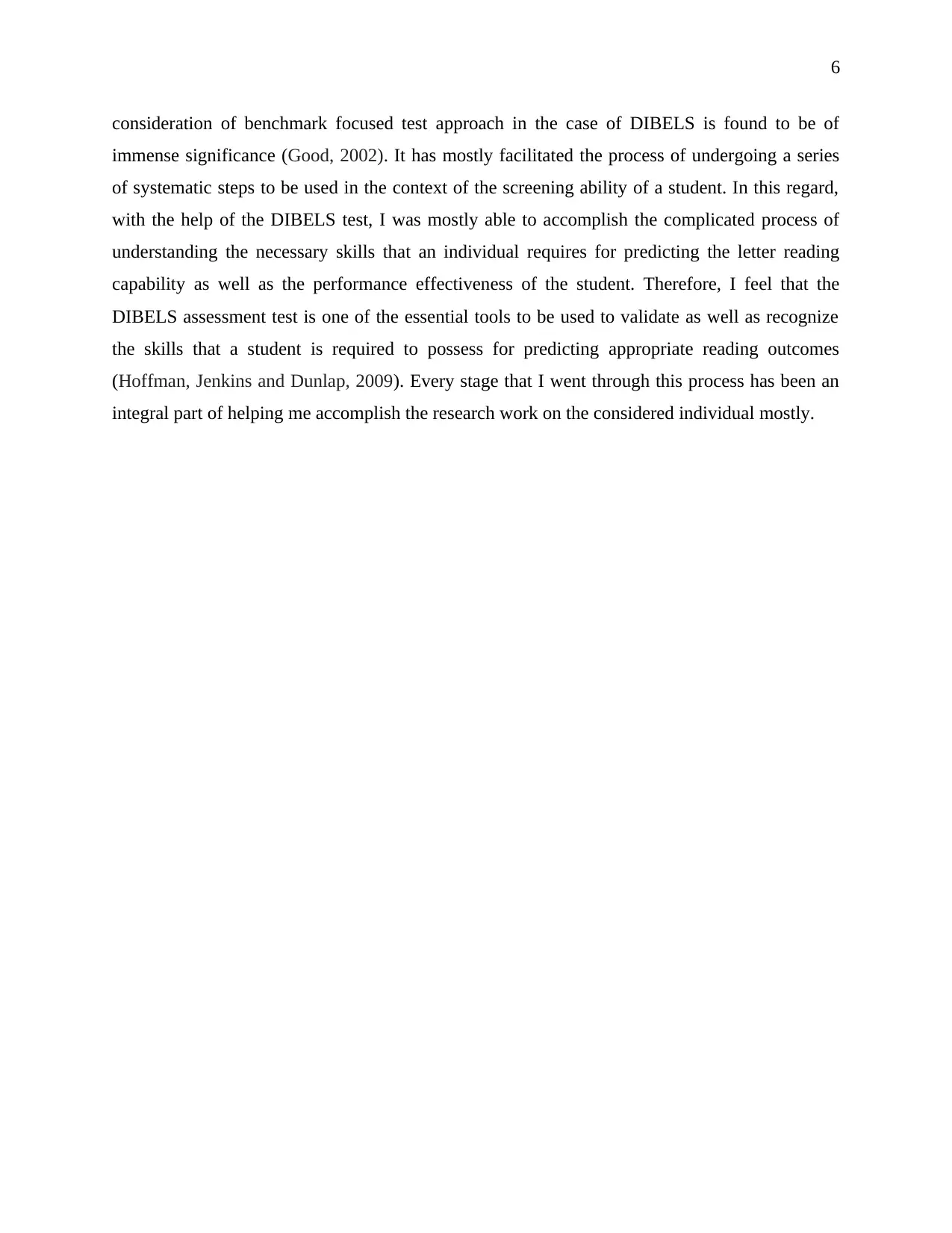
6
consideration of benchmark focused test approach in the case of DIBELS is found to be of
immense significance (Good, 2002). It has mostly facilitated the process of undergoing a series
of systematic steps to be used in the context of the screening ability of a student. In this regard,
with the help of the DIBELS test, I was mostly able to accomplish the complicated process of
understanding the necessary skills that an individual requires for predicting the letter reading
capability as well as the performance effectiveness of the student. Therefore, I feel that the
DIBELS assessment test is one of the essential tools to be used to validate as well as recognize
the skills that a student is required to possess for predicting appropriate reading outcomes
(Hoffman, Jenkins and Dunlap, 2009). Every stage that I went through this process has been an
integral part of helping me accomplish the research work on the considered individual mostly.
consideration of benchmark focused test approach in the case of DIBELS is found to be of
immense significance (Good, 2002). It has mostly facilitated the process of undergoing a series
of systematic steps to be used in the context of the screening ability of a student. In this regard,
with the help of the DIBELS test, I was mostly able to accomplish the complicated process of
understanding the necessary skills that an individual requires for predicting the letter reading
capability as well as the performance effectiveness of the student. Therefore, I feel that the
DIBELS assessment test is one of the essential tools to be used to validate as well as recognize
the skills that a student is required to possess for predicting appropriate reading outcomes
(Hoffman, Jenkins and Dunlap, 2009). Every stage that I went through this process has been an
integral part of helping me accomplish the research work on the considered individual mostly.
⊘ This is a preview!⊘
Do you want full access?
Subscribe today to unlock all pages.

Trusted by 1+ million students worldwide
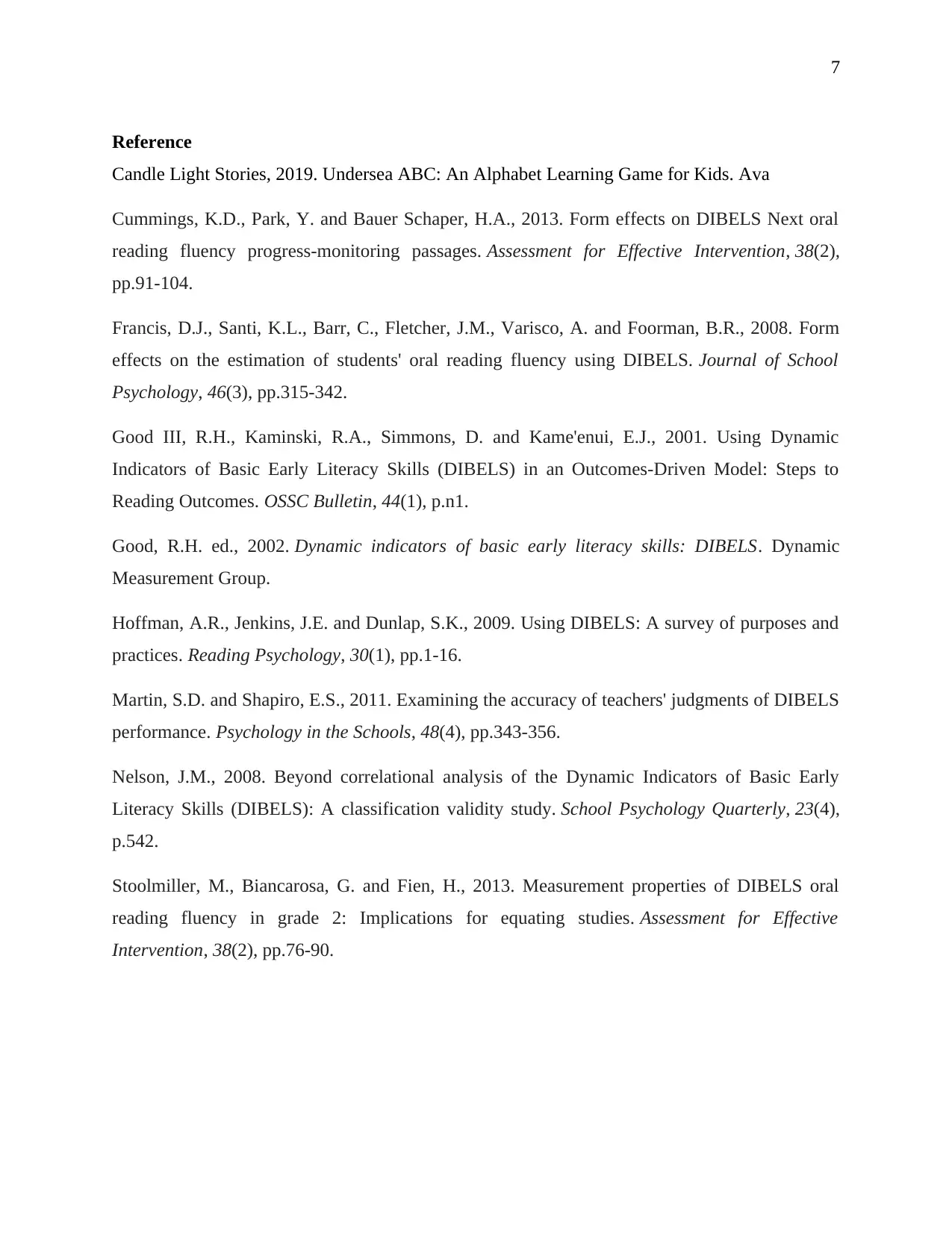
7
Reference
Candle Light Stories, 2019. Undersea ABC: An Alphabet Learning Game for Kids. Ava
Cummings, K.D., Park, Y. and Bauer Schaper, H.A., 2013. Form effects on DIBELS Next oral
reading fluency progress-monitoring passages. Assessment for Effective Intervention, 38(2),
pp.91-104.
Francis, D.J., Santi, K.L., Barr, C., Fletcher, J.M., Varisco, A. and Foorman, B.R., 2008. Form
effects on the estimation of students' oral reading fluency using DIBELS. Journal of School
Psychology, 46(3), pp.315-342.
Good III, R.H., Kaminski, R.A., Simmons, D. and Kame'enui, E.J., 2001. Using Dynamic
Indicators of Basic Early Literacy Skills (DIBELS) in an Outcomes-Driven Model: Steps to
Reading Outcomes. OSSC Bulletin, 44(1), p.n1.
Good, R.H. ed., 2002. Dynamic indicators of basic early literacy skills: DIBELS. Dynamic
Measurement Group.
Hoffman, A.R., Jenkins, J.E. and Dunlap, S.K., 2009. Using DIBELS: A survey of purposes and
practices. Reading Psychology, 30(1), pp.1-16.
Martin, S.D. and Shapiro, E.S., 2011. Examining the accuracy of teachers' judgments of DIBELS
performance. Psychology in the Schools, 48(4), pp.343-356.
Nelson, J.M., 2008. Beyond correlational analysis of the Dynamic Indicators of Basic Early
Literacy Skills (DIBELS): A classification validity study. School Psychology Quarterly, 23(4),
p.542.
Stoolmiller, M., Biancarosa, G. and Fien, H., 2013. Measurement properties of DIBELS oral
reading fluency in grade 2: Implications for equating studies. Assessment for Effective
Intervention, 38(2), pp.76-90.
Reference
Candle Light Stories, 2019. Undersea ABC: An Alphabet Learning Game for Kids. Ava
Cummings, K.D., Park, Y. and Bauer Schaper, H.A., 2013. Form effects on DIBELS Next oral
reading fluency progress-monitoring passages. Assessment for Effective Intervention, 38(2),
pp.91-104.
Francis, D.J., Santi, K.L., Barr, C., Fletcher, J.M., Varisco, A. and Foorman, B.R., 2008. Form
effects on the estimation of students' oral reading fluency using DIBELS. Journal of School
Psychology, 46(3), pp.315-342.
Good III, R.H., Kaminski, R.A., Simmons, D. and Kame'enui, E.J., 2001. Using Dynamic
Indicators of Basic Early Literacy Skills (DIBELS) in an Outcomes-Driven Model: Steps to
Reading Outcomes. OSSC Bulletin, 44(1), p.n1.
Good, R.H. ed., 2002. Dynamic indicators of basic early literacy skills: DIBELS. Dynamic
Measurement Group.
Hoffman, A.R., Jenkins, J.E. and Dunlap, S.K., 2009. Using DIBELS: A survey of purposes and
practices. Reading Psychology, 30(1), pp.1-16.
Martin, S.D. and Shapiro, E.S., 2011. Examining the accuracy of teachers' judgments of DIBELS
performance. Psychology in the Schools, 48(4), pp.343-356.
Nelson, J.M., 2008. Beyond correlational analysis of the Dynamic Indicators of Basic Early
Literacy Skills (DIBELS): A classification validity study. School Psychology Quarterly, 23(4),
p.542.
Stoolmiller, M., Biancarosa, G. and Fien, H., 2013. Measurement properties of DIBELS oral
reading fluency in grade 2: Implications for equating studies. Assessment for Effective
Intervention, 38(2), pp.76-90.
1 out of 7
Your All-in-One AI-Powered Toolkit for Academic Success.
+13062052269
info@desklib.com
Available 24*7 on WhatsApp / Email
![[object Object]](/_next/static/media/star-bottom.7253800d.svg)
Unlock your academic potential
Copyright © 2020–2025 A2Z Services. All Rights Reserved. Developed and managed by ZUCOL.